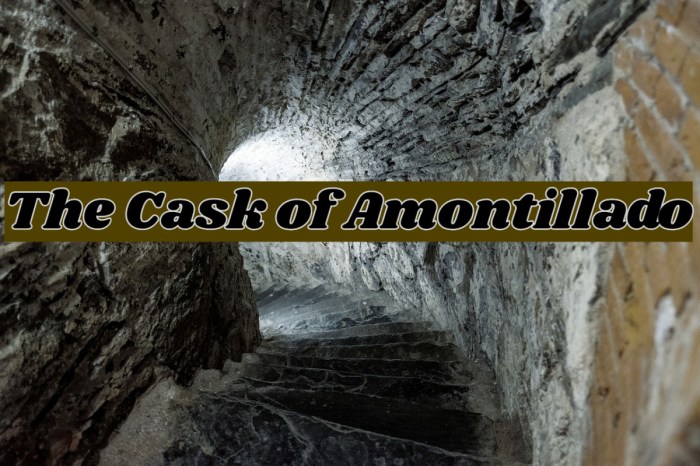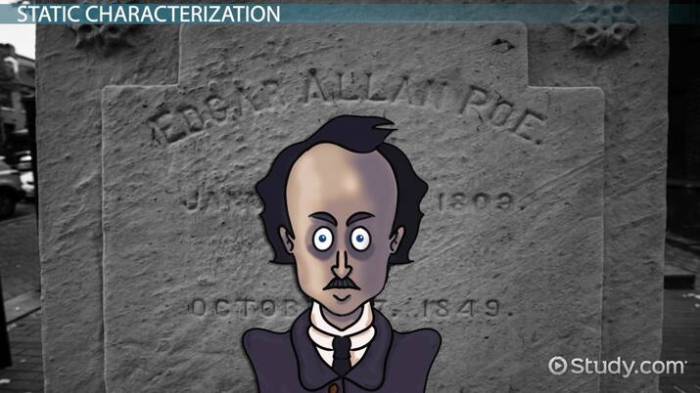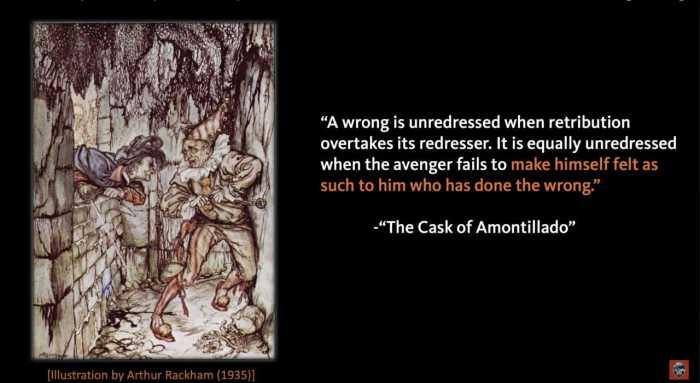The cask of amontillado literary devices – The Cask of Amontillado, a haunting tale of revenge and deceit, showcases a masterful use of literary devices that captivates readers and leaves a lasting impression. From allegory and foreshadowing to irony and gothic elements, Edgar Allan Poe’s short story employs a range of techniques to enhance its suspense, tension, and tragic outcome.
As we delve into the literary devices employed in The Cask of Amontillado, we will uncover the allegorical and symbolic meanings embedded within the story, identify instances of foreshadowing that build suspense and create a sense of foreboding, and examine the use of irony and dramatic irony to contribute to the story’s tension and tragic outcome.
Allegory and Symbolism

The cask of Amontillado symbolizes the secrets and sins that Montresor keeps hidden within his soul. The catacombs represent the depths of Montresor’s depravity and the darkness that consumes him. The Montresor family motto, “Nemo me impune lacessit” (No one attacks me with impunity), foreshadows Montresor’s desire for revenge and his belief that he is above the law.
Foreshadowing and Suspense
Poe uses several instances of foreshadowing to build suspense and create a sense of foreboding. For example, Montresor’s mention of the “thousand injuries” that Fortunato has inflicted upon him hints at the severity of Montresor’s revenge. The use of the word “catacombs” also foreshadows the dark and dangerous place where Montresor will lead Fortunato.
Irony and Dramatic Irony
The story contains several examples of situational irony and dramatic irony. Situational irony occurs when the outcome of a situation is the opposite of what is expected. For example, Fortunato believes that he is going to taste a rare wine, but he is actually being led to his death.
Dramatic irony occurs when the audience knows something that the characters do not. For example, the reader knows that Montresor is planning to kill Fortunato, but Fortunato is unaware of this.
Point of View and Narrative Structure
The story is told from the first-person point of view of Montresor. This perspective allows the reader to experience the events of the story through Montresor’s eyes and to understand his motivations. The non-linear narrative structure adds to the story’s suspense and complexity.
By withholding information and revealing it gradually, Poe keeps the reader guessing about what will happen next.
Gothic Elements
The story contains several gothic elements, such as the dark and gloomy setting, the atmosphere of suspense and dread, and the characters who are driven by dark passions. The use of these elements creates a sense of mystery and horror that is characteristic of the gothic genre.
Character Analysis
Montresor is a complex and enigmatic character. He is driven by a desire for revenge and a belief that he is above the law. Fortunato is a wealthy and arrogant man who is unaware of the danger he is in.
The contrasting personalities of Montresor and Fortunato drive the conflict in the story.
Theme and Meaning, The cask of amontillado literary devices
The story explores several themes, such as revenge, guilt, and the dangers of pride. Montresor’s desire for revenge leads him to commit a terrible crime, but he is ultimately unable to escape the guilt of his actions. Fortunato’s pride and arrogance lead him to his death.
The story warns against the dangers of allowing one’s passions to control one’s actions.
Key Questions Answered: The Cask Of Amontillado Literary Devices
What is the significance of the Montresor family motto, “Nemo me impune lacessit”?
The motto, meaning “No one attacks me with impunity,” reflects Montresor’s pride and determination to avenge the perceived insults of Fortunato.
How does the use of foreshadowing contribute to the story’s suspense?
Poe employs subtle hints and clues throughout the story, such as Montresor’s insistence on Fortunato wearing a jester’s cap and bells, to foreshadow the gruesome fate that awaits him.
What is the effect of the non-linear narrative structure on the story?
The non-linear structure, with Montresor recounting the events after the crime has been committed, creates a sense of suspense and uncertainty, as readers are gradually piecing together the events leading up to the tragic outcome.

